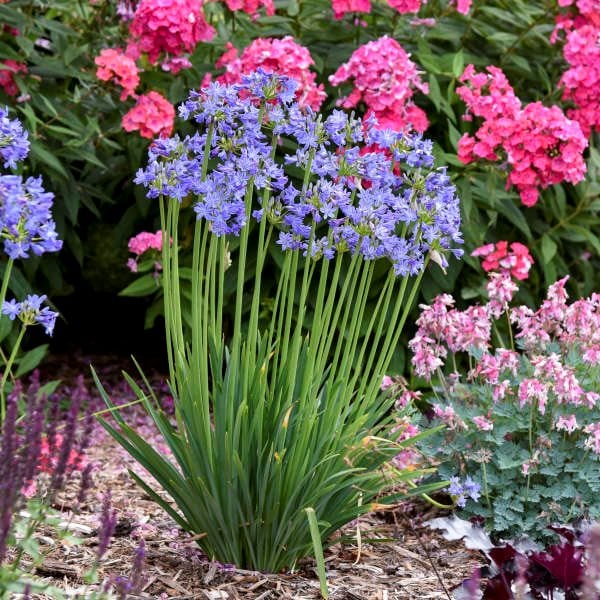Just how to Plant and Maintain Agapanthus in Your Garden
Just how to Plant and Maintain Agapanthus in Your Garden
Blog Article
Understanding the Art of Agapanthus Treatment: Necessary Steps for Healthy And Balanced Growth and Vibrant Flowers
In the realm of cultivation, the growing of agapanthus stands as a gratifying endeavor for those who seek to support these sophisticated flowering plants. With their striking blooms and stylish vegetation, agapanthus has actually caught the attention of gardeners worldwide. However, attaining ideal development and lively blossoms requires a nuanced technique that incorporates different necessary steps. From choosing the best selection to understanding trimming techniques, the trip in the direction of cultivating flourishing agapanthus plants is complex and holds the key to unlocking the full potential of these herb gems.

Selecting the Right Agapanthus Range

When selecting the ideal Agapanthus variety for your garden, take into consideration factors such as environment viability, blossom shade, and growth behavior. Agapanthus, generally understood as Lily of the Nile or African lily, is available in a range of colors varying from shades of blue and purple to white. Choose a bloom shade that complements your existing garden palette to produce a harmonious landscape. Additionally, consider the environment in your region to guarantee the Agapanthus range you select can thrive in your specific conditions. Some varieties are extra forgiving of chilly temperatures, while others choose warmer environments. Recognizing the development routine of different Agapanthus selections is crucial for appropriate positioning within your yard. Some ranges have a clumping growth routine, suitable for boundaries or containers, while others have a more dispersing nature, ideal for ground cover or mass growings. By very carefully reviewing these variables, you can pick the ideal Agapanthus range to enhance the appeal of your garden.
Suitable Growing Problems
Thinking about the optimum environmental demands is essential for successful Agapanthus farming. Agapanthus grows in well-draining soil with a slightly acidic to neutral pH degree. When growing, choose an area that obtains full sunshine to partial color. In hotter climates, offering some afternoon color can prevent scorching of the fallen leaves. Agapanthus plants are sensitive to chilly temperatures and must be protected from frost during winter season.
To make certain healthy growth and vivid flowers, plant Agapanthus light bulbs at a deepness of concerning 2-4 inches and area them 8-12 inches apart. Adding raw material, such as compost, to the dirt can enhance water drainage and fertility, advertising durable root development. Mulching around the base of the plants helps keep moisture and reduces weed growth. Routine my link watering is critical, specifically throughout the growing period, to keep the dirt consistently wet yet not saturated.
Watering and Fertilizing Tips
Maintaining correct dampness degrees and giving crucial nutrients are crucial components in the treatment routine for Agapanthus plants. When it pertains to watering Agapanthus, it is critical to strike a balance. If overwatered, these plants favor continually moist soil yet are vulnerable to root rot. During the growing season, water deeply once a week, making certain the dirt is well-draining to stop waterlogging. In hotter climates or during durations of dry spell, more constant watering might be required to maintain the soil uniformly moist. Nonetheless, minimize watering in the winter season to avoid water logged conditions.
Feeding Agapanthus is important for promoting healthy and balanced growth and respected blossoms. Use a balanced fertilizer, such as a 10-10-10 formula, in the very early spring as brand-new growth emerges. By complying with these watering and feeding pointers, you can guarantee your Agapanthus plants grow and generate vivid, lasting blooms.
Trimming Methods for Agapanthus
Trimming Agapanthus plants at the appropriate times and with proper strategies is essential for preserving their health and wellness and advertising optimal growth and flowering. The optimal time to trim Agapanthus is in late wintertime or very early spring before brand-new growth emerges.
Deadheading spent flowers can likewise reroute the plant's power into generating even more flowers instead than setting seeds. If you desire to accumulate seeds for propagation, leave some flowers to fully grown and dry on the plant.
Remember to utilize tidy, sharp tools to make precise cuts and decrease the threat of presenting diseases. Agapanthus. Normal pruning will aid keep your Agapanthus looking cool and healthy while guaranteeing a bountiful screen of stunning blossoms
Handling Common Insects and Diseases
After making sure correct pruning strategies for Agapanthus, it is essential to attend to typical parasites and diseases that can affect the health imp source and vitality of these plants. One common insect that influences Agapanthus is the Agapanthus gall midge.
Additionally, Agapanthus plants can suffer from root rot if they are planted in inadequately draining dirt. By being alert and taking timely action versus diseases and pests, you can help your Agapanthus plants thrive and produce vibrant blooms. Agapanthus.

Verdict
Finally, grasping the art of agapanthus care includes choosing the appropriate selection, providing suitable planting problems, proper watering and feeding, ideal trimming methods, and attending to typical bugs and conditions. By following these essential steps, you can make certain healthy development and dynamic blossoms for your agapanthus plants. Bear in mind to routinely monitor and preserve your plants to promote their total health and durability.
To make certain healthy development and dynamic flowers, plant Agapanthus light bulbs at a deepness of about 2-4 inches and room them 8-12 inches apart. By complying with these watering and fertilizing ideas, you can ensure your Agapanthus plants grow and create vivid, lasting flowers.
One usual insect that influences learn the facts here now Agapanthus is the Agapanthus gall midge. Additionally, Agapanthus plants can suffer from origin rot if they are planted in improperly draining soil. By adhering to these vital actions, you can guarantee healthy and balanced development and dynamic blooms for your agapanthus plants.
Report this page